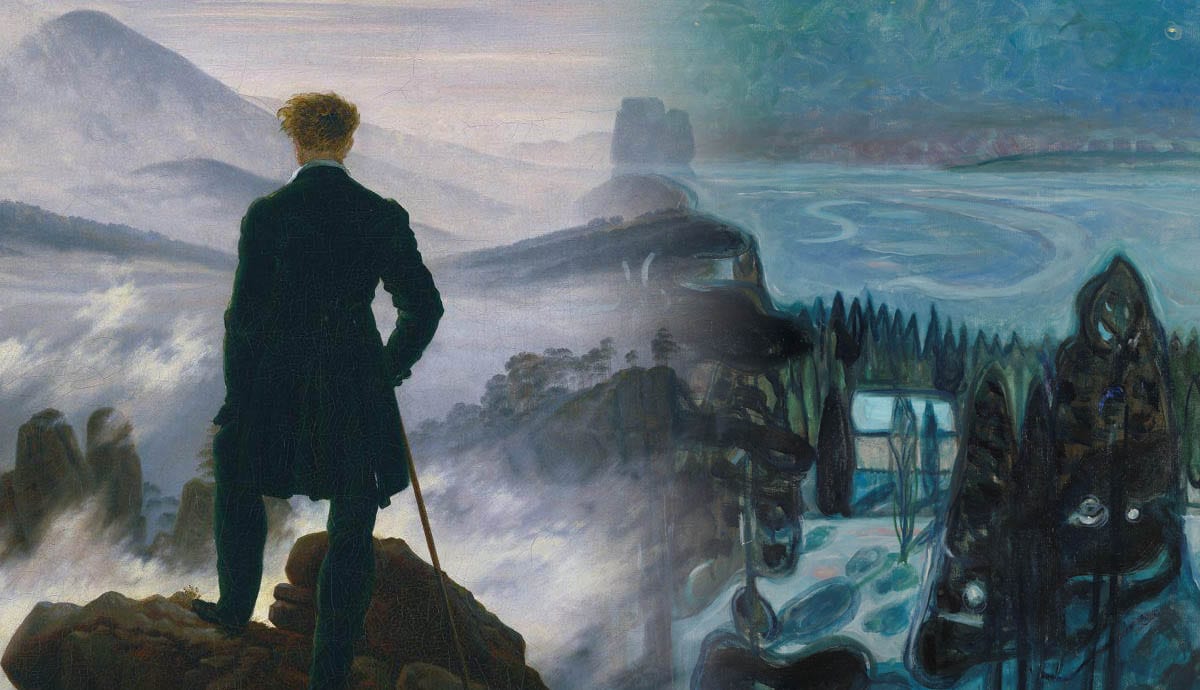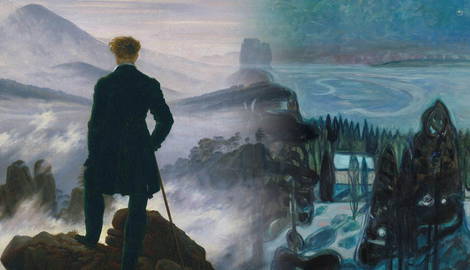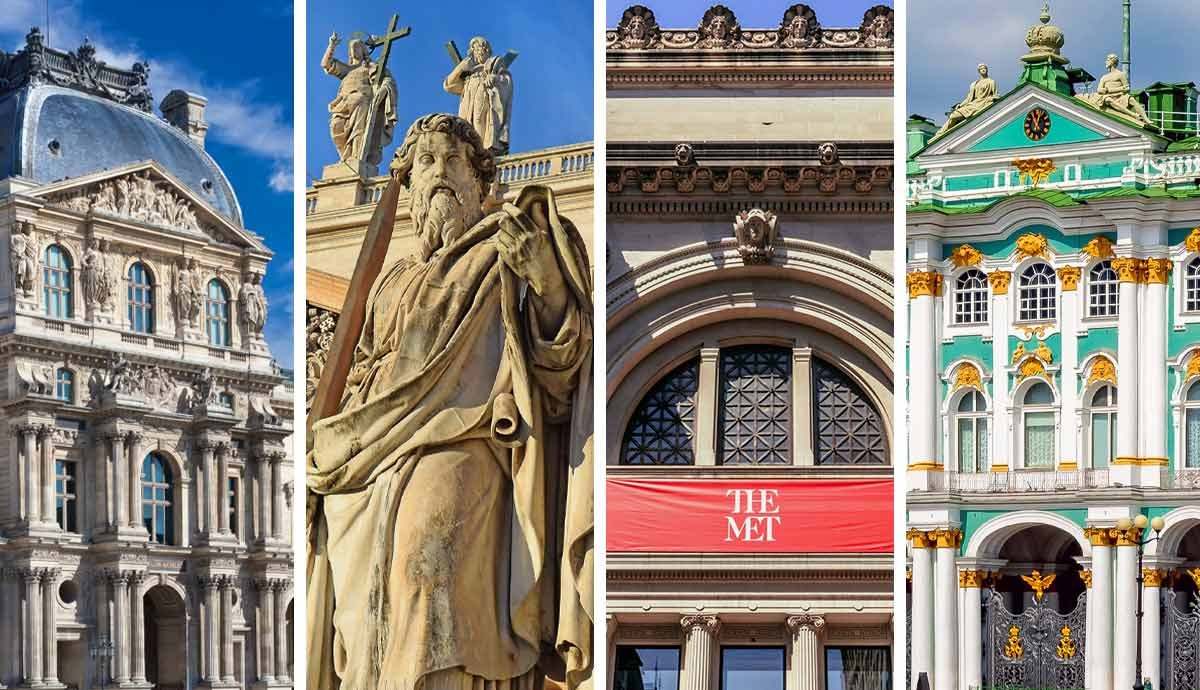
Sublime landscape paintings are one of art history’s most theatrical and emotive subjects, combining beauty, drama, and devastation in equal measure. The term ‘sublime’ was defined by the philosopher Edmund Burke’s A Philosophical Enquiry into the Origin of Our Ideas of the Sublime and Beautiful in 1757 as beauty laced with something extra, a certain danger, fear or horror, or what he called: “whatever is in any sort terrible or is conversant about terrible objects or operates in a manner analogous to terror.” Burke has also called sublime no less than the most powerful emotion the mind can feel – no wonder artists were keen to adopt the style!
Sublime Landscape Painting Through History
Although the term sublime could describe various subjects, sublime landscape paintings have been some of the most enduring and captivating of them all. Even before Burke’s famous text, painters since medieval times have ramped up swirling storm clouds, sharp cliff faces and jagged, snow-peaked mountains to convey an overwhelming wonder and terror to captivated audiences. Let’s get lost in some of the most awe-inspiring, sublime landscape paintings of all time, from the Renaissance era to modern and contemporary times.
1. Pieter Brueghel the Elder, Landscape with the Flight into Egypt, 1563

Pieter Brueghel the Elder’s, Landscape with the Flight into Egypt, 1563 typifies sublime landscape painting of the Northern Renaissance, combining breath-taking scenery with religious narrative. The tiny figures of Mary and Joseph teeter along a perilous cliff face in the foreground, fleeing persecution in Bethlehem. The scenery is tied closely to their story as pale, distant scenery represents the familiar land they are leaving behind, while the dark, foreboding foreground which they head towards is shrouded in the darkness and danger of the unknown. Breughel sought to contrast areas of stillness and motion within this single image, painting the rocks and mountains as a steady and unmoving constant, in comparison to the constantly flowing movement of water, people, and birds. This balance of opposites between darkness/light, fragility/permanence, and stillness/movement is why this sublime landscape painting has become one of the most enduring images of all time.
2. Philip James De Loutherbourg, An Avalanche in the Alps, 1803

The British-based, French-born Philip James De Loutherbourg painted An Avalanche in the Alps in 1803, at a time when the picturesque yet dangerous French Alps were an increasingly popular embodiment of the sublime landscape. As well as a painter, De Loutherbourg moonlighted as a theatre set designer, a role which allowed him to invest overwhelming drama into his canvases through stark lighting, depth, and movement. Here the distant French mountains are beginning to crumble away into an avalanche, casting terrifyingly huge clouds of billowing dust and smoke across the scene and obscuring the sky above. A flash of white light in the center draws our eye to the tiny, terrified onlookers who are minuscule in the face of the falling rocks around them, soon to be destroyed by the elemental forces of nature.
3. Joseph Mallord William Turner, Snow Storm: Hannibal and his Army Crossing the Alps, 1812

J.M.W. Turner’s Snow Storm: Hannibal and his Army Crossing the Alps, 1812, typifies the agonizing beauty of the Romanticism era, with monstrous, arching storm clouds that soar over small people below. Dedicated to Hannibal Barca, Commander of the Carthaginian army in 200-100 BC, the painting conveys Hannibal’s soldiers attempting to cross the Alps in 218 BC, with Salassian tribesmen fighting Hannibal’s rear-guard. Here the storm becomes a potent metaphor for life-threatening struggle as black, angry clouds form a terrifying, swirling vortex that pushes back against the tiny, helpless soldiers. In the distance, the sun is a glowing orb of mesmerizing light, a glimmer of hope amidst the tragedy of war. But beyond narrative references, this sublime landscape of Turner’s is ultimately a reflection on the sheer, destructive brutality of nature, which threatens to callously engulf the people below.
4. Caspar David Friedrich, Wanderer Above Sea Fog, 1817

One of the most iconic and sublime landscape paintings of all time, German painter Caspar David Friedrich’s, Wanderer Above Sea Fog, 1817, encapsulates the dreamy idealistic spirit of European Romanticism. Standing alone on a high dark rock a lone figure contemplates his place in the universe, while foggy mist swarms over the distant valleys and mountains beyond. Friedrich conveys the sublime landscape here as inhospitable and unknowable terrain, reflecting the nineteenth-century fascination with wild, unbridled nature.
In contrast with other artists of the era who tended to create small figures to emphasize the magnitude of the landscape, Friedrich gives his figure a central role but when seen from behind he retains his anonymity as an abstract ‘wanderer’, acting as a symbol for all wistful dreamers of the nineteenth century and beyond. The scene is an imaginary take on Germany’s mountainous countryside; to create such mystical places Friedrich searched inwards, writing, “Close your physical eye, so that you may see your picture first with the spiritual eye. Then bring what you saw in the dark into the light, so that it may have an effect on others, shining inwards from outside.”
5. Karl Eduard Biermann, The Wetterhorn, 1830

Karl Eduard Biermann’s The Wetterhorn, 1830, encapsulates the German painter’s sublime landscape painting style, with a vast, rugged terrain set amidst dramatic theatrical lighting. The craggy foreground is painted carefully in rich dark tones of green and brown, leading us towards a band of trees and rocks that disappear into black shadow. In the background an epic mountain range is lit by a shaft of sunlight, emphasizing its freezing, pointed spires as a mystical and unreachable place, while clouds swarm overhead as if threatening to break into a storm. Like many Romanticist painters, Biermann emphasizes the awe, wonder, and terrifying scale of the scene by placing two tiny figures in the foreground who allow us to imagine ourselves in the midst of the scene. They attempt to climb across uneven rocks and marshy grass, while an angry waterfall gushes past them and catches the light like a streak of lightning, splitting their perilous journey apart.
6. Arnold Bocklin, The Island of the Dead, 1880

One of the most hauntingly sublime landscape paintings ever made, German painter Arnold Bocklin’s The Island of the Dead, 1880, conveys an imaginary island rising from the sea against a dark, brooding sky. The painting was commissioned by the recently widowed Marie Berna, who requested only “a picture to dream over.” Responding to her request, Bocklin invested his image with allusions to death and mourning. In the foreground, a ghostly white figure is steered towards the island on a small rowing boat alongside an object resembling a coffin. The rower has been compared with the ancient Greek character of Charon the boatman, who ferried the souls of the dead across the river Styx to Hades. Lining the island are rows of menacingly dark Cypress trees traditionally associated with graveyards, while the jagged glowing rocks beyond are cut into with sepulchral doors and windows. In contrast with many sublime landscapes, spooky stillness pervades the scene, lending it an eerie silence; Bocklin himself even described the work as “so silent that you would get a fright when there was a knock on the door.”
7. Edvard Munch, White Night, 1901

Edvard Munch made White Night, 1901 in his later career, at a time when he had abandoned figuration in favor of atmospheric landscapes, but the same pervading anxiety of his earlier art remained. This sublime landscape painting portrays his native Norway in the depths of winter, looking down across menacingly dark trees to a frozen fjord. A forest of spruce trees forms a jagged edge as sharp as a saw-edge, a warning of the hazardous ice beyond. Black trees in the foreground suggest faces or phantom creatures but they are barely recognizable under the cloak of nightfall. Combining glistening moonlight with these qualities of danger and threat, Munch’s night-time winter scene captures the sublime beauty of the Norwegian winter. Reflecting on the ways his landscape scenes could merge observations with the inner mind, Munch wrote, “Nature is not only all that is visible to the eye… it also includes the inner pictures of the soul.”
8. Akseli Gallen-Kallela, Lake Keitele, 1904

Askeli Gallen-Kallela’s Lake Keitele, 1904, conveys the famous Finish lake as a mesmerizing mirror of light torn through with zig-zagging currents of wind. The painting was made at a time when a growing desire for independence was being felt across Finland. Celebrating the country’s great unspoiled wilderness, this sublime landscape painting became a potent symbol for Finnish nationalism and pride. Although there is no sign of human life, natural currents of movement seen running through the water were a well-known feature of the lake. These streaks of motion were so historically well-known that in ancient Finnish culture they were linked with the mythological character of Väinämöinen, who was said to leave ripples as he traveled across the lake. These subtle depictions of the movement held great nationalist symbolism for Gallen-Kallela, celebrating the mysterious and enigmatic beauty of ancient Finnish culture and its close ties with the land. He described them as, “silvery stripes at the surface of the serene water are the wavelets announcing the passion to come.”
9. Thomas Moran, The Grand Canyon of the Colorado, 1904

In Thomas Moran’s The Grand Canyon of the Colorado, 1904, the vast expansiveness of this famous national park is conveyed on an enormous, panoramic scale of seven by ten feet. A leader in both the Hudson River and Rocky Mountain Schools, American painter Moran was so entranced by Colorado’s dangerously beautiful unspoiled terrain that he immersed himself deeply into a landscape where few had ventured before him, painting more than thirty scenes capturing this unique, sublime landscape. Observing with fascination the great open space beyond him, he wrote, “its tremendous architecture fills one with wonder and admiration, and its color, forms, and atmosphere are so ravishingly beautiful that, however well-traveled one may be, a new world is opened to him when he gazes into the Grand Canyon.”
This scene conveys an idealized and romanticized vision of the Grand Canyon as sharp rocks fall in and out of the light before fading into the distant horizon, while an encroaching storm gathers pace overhead. Audiences were so dazzled by Moran’s portrayals of the great American wilderness that he is credited today with influencing the creation of the national park system that has preserved the integrity of America’s sublime landscape.
10. Peter Doig, Ski Jacket, 1994

Scottish painter Peter Doig’s Ski Jacket, 1994, is a flurry of snow-peaked energy and movement. Based on a photographic image with learner skiers scattered across a Japanese mountain, Doig deliberately distorts and disrupts the original image, slicing it into two parts across the middle and putting it back together again to create an eerily mirrored Rorschach effect. Doig is well-known for merging photographic material with painterly marks, allowing the two conflicting styles to play off one another as seen in this image, where carefully painted trees are surrounded by loosely layered washes of pink, white and green. These aqueous passages of paint suggest the cold, slippery qualities of ice and snow that permeate the image and lend it a dangerous uncertainty, reinforcing the fear of the tiny skiers struggling against the treacherously steep terrain around them.
Legacy Of Sublime Landscape Painting
The sublime was declared ‘out of date’ in the 19th century, fading in favor of French Impressionism. However, sublime landscape painting made a comeback in the 20th century when Abstract Expressionists explored the same existentialist, transcendent themes in their painting. Artists such as Mark Rothko, Clyfford Still and Robert Smithson have all used elements of the sublime in their work.










